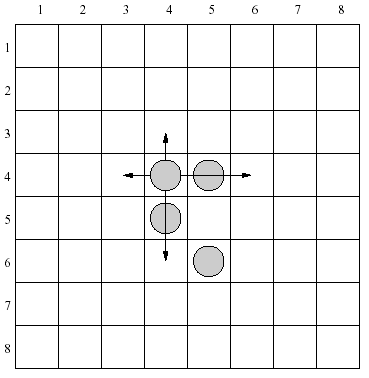hdu 1401 Solitaire(双向bfs)
2014-05-23 17:04
246 查看
Solitaire
Time Limit: 2000/1000 MS (Java/Others) Memory Limit: 65536/32768 K (Java/Others)Total Submission(s): 3141 Accepted Submission(s): 976
Problem Description
Solitaire is a game played on a chessboard 8x8. The rows and columns of the chessboard are numbered from 1 to 8, from the top to the bottom and from left to right respectively.
There are four identical pieces on the board. In one move it is allowed to:
> move a piece to an empty neighboring field (up, down, left or right),
> jump over one neighboring piece to an empty field (up, down, left or right).

There are 4 moves allowed for each piece in the configuration shown above. As an example let's consider a piece placed in the row 4, column 4. It can be moved one row up, two rows down, one column left or two columns right.
Write a program that:
> reads two chessboard configurations from the standard input,
> verifies whether the second one is reachable from the first one in at most 8 moves,
> writes the result to the standard output.
Input
Each of two input lines contains 8 integers a1, a2, ..., a8 separated by single spaces and describes one configuration of pieces on the chessboard. Integers a2j-1 and a2j (1 <= j <= 4) describe the position of one piece - the row number and the column number
respectively. Process to the end of file.
Output
The output should contain one word for each test case - YES if a configuration described in the second input line is reachable from the configuration described in the first input line in at most 8 moves, or one word NO otherwise.
Sample Input
4 4 4 5 5 4 6 5 2 4 3 3 3 6 4 6
Sample Output
YES
Source
Southwestern Europe 2002
题意:给定8*8的棋盘,上面有4个棋子,给定初始态和结束态,问是否可以在8步之内到达
题解:明显每一种状态有16种转移所得的状态,若普通的bfs的复杂度就是16的8次方,即2的32次方。。。无法接受
当是考虑到给定初始态和结束态,可以2边同时进行4步bfs,仅需判断是否相交就行了,复杂度就是2*16的4次方,即2的17次方,完全可以接受
#include<stdio.h>
#include<string.h>
#include<algorithm>
#include<queue>
#include<map>
using namespace std;
typedef unsigned long long ll;
struct point
{
int x,y;
};
struct node
{
point p[4];
int step;
} sta,fin;
int cou=0;
int dx[]= {0,0,1,-1};
int dy[]= {1,-1,0,0};
int check(point p1)
{
if(p1.x<0||p1.x>=8||p1.y<0||p1.y>=8) return 0;
return 1;
}
ll gethash(node now)
{
ll tmp=0;
for(int i=0; i<4; i++) tmp|=((ll)1)<<(now.p[i].x*8+now.p[i].y);
return tmp;
}
map<ll,int>mp;
int bfs(int type,node now)
{
queue<node>q;
if(type==2)
{
if(mp.find(gethash(now))!=mp.end()) return 1;
}
mp[gethash(now)]=type;
now.step=0;
q.push(now);
while(!q.empty())
{
now=q.front();
q.pop();
if(now.step>=4) continue;
for(int i=0; i<4; i++)
{
for(int j=0,k; j<4; j++)
{
cou++;
node temp=now;
temp.step++;
temp.p[j].x+=dx[i];
temp.p[j].y+=dy[i];
if(!check(temp.p[j])) continue;
ll tmp=gethash(temp);
for(k=0; k<4; k++)
{
if(k==j) continue;
if(temp.p[j].x==temp.p[k].x&&temp.p[j].y==temp.p[k].y) break;
}
if(k==4)
{
if(mp.find(tmp)==mp.end())
{
mp[tmp]=type;
q.push(temp);
}
else if(mp[tmp]!=type) return 1;
}
else
{
temp.p[j].x+=dx[i];
temp.p[j].y+=dy[i];
tmp=gethash(temp);
if(!check(temp.p[j])) continue;
for(k=0; k<4; k++)
{
if(k==j) continue;
if(temp.p[j].x==temp.p[k].x&&temp.p[j].y==temp.p[k].y) break;
}
if(k<4) continue;
if(mp.find(tmp)==mp.end())
{
mp[tmp]=type;
q.push(temp);
}
else if(mp[tmp]!=type) return 1;
}
}
}
}
return 0;
}
int main()
{
while(scanf("%d%d",&sta.p[0].x,&sta.p[0].y)>0)
{
for(int i=1; i<4; i++) scanf("%d%d",&sta.p[i].x,&sta.p[i].y);
for(int i=0; i<4; i++) scanf("%d%d",&fin.p[i].x,&fin.p[i].y);
for(int i=0; i<4; i++) sta.p[i].x--,sta.p[i].y--;
for(int i=0; i<4; i++) fin.p[i].x--,fin.p[i].y--;
mp.clear();
bfs(1,sta);
int temp=bfs(2,fin);
printf("%s\n",temp?"YES":"NO");
}
return 0;
}
相关文章推荐
- HDU 1401 Solitaire(双向BFS)
- HDU 1401 Solitaire [双向BFS]
- hdu 1401 Solitaire 双向bfs
- HDU 1401 Solitaire 双向BFS
- HDU 1401 Solitaire 双向BFS
- HDU 1401 Solitaire(双向搜索)
- HDU 1401 Solitaire(双向广度优先搜索)
- HDOJ 题目1401 Solitaire(双向BFS)
- HDU_1401——同步双向BFS,八进制位运算压缩,map存放hash
- hdu 1401 Solitaire(bfs)
- hdu 1401/poj 1198 Solitaire(BFS,剪枝)
- HDU 1401 双向BFS !!!
- HDU 1401 Solitaire (双向搜索)
- hdu 1401 双向bfs
- HDU_1401——分步双向BFS,八进制乘权值压缩,map存放hash
- HDU 1401 Solitaire(棋盘状态BFS)
- hdu 1401 Solitaire 双向广度搜索
- HDU_1401——分步双向BFS,八进制位运算压缩,map存放hash
- hdu 1401 Solitaire(双向宽搜)
- hdu 1401 双向搜索(bfs)
